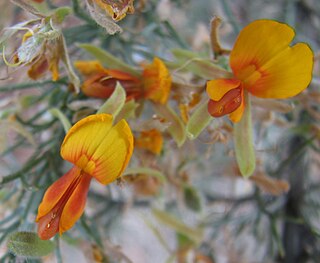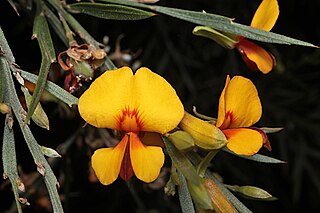
Jacksonia furcellata, commonly known as grey stinkwood, is a species of flowering plant in the family Fabaceae and is endemic to the south-west of Western Australia. It is a prostrate to low-lying, or weeping erect shrub with greyish-green branches, sharply-pointed side branches, its leaves reduced to scales leaves, yellowish-orange flowers, and woody, hairy pods.

Jacksonia sternbergiana, commonly known as stinkwood, is a species of flowering plant in the family Fabaceae and is endemic to the south-west of Western Australia. The Noongar peoples know the plant as kabbur, koorpa or mondurn. It is an erect or weeping shrub or tree with dull green branches, straight, sharply-pointed side branches, its leaves reduced to scales, yellowish-orange flowers, and woody, hairy pods.

Jacksonia horrida is a species of flowering plant in the family Fabaceae and is endemic to the south-west of Western Australia. It is an erect or spreading to prostrate, bushy shrub with greyish-green branches ending in short, flattened, sharply-pointed side branches, the leaves reduced to scales and the flowers scattered and yellow-orange with red markings.

Jacksonia anthoclada is a species of flowering plant in the family Fabaceae and is endemic to the south-west of Western Australia. It is an erect, single-stemmed shrub with hairy, elliptic to egg-shaped phylloclades with sharply-pointed edges, yellow-orange flowers with red markings, and hairy, woody pods.

Jacksonia acicularis is a species of flowering plant in the family Fabaceae and is endemic to the west of Western Australia. It is an erect, spindly shrub with very sharply-pointed short side branches, leaves reduced to scales, orange flowers with red markings, and densely hairy pods.

Jacksonia aculeata is a species of flowering plant in the family Fabaceae and is endemic to the northern Australia. It is a spreading shrub with sharply-pointed, hairy, short side branches, leaves reduced to scales, lemon-yellow flowers, and woody, hairy pods.

Jacksonia alata is a species of flowering plant in the family Fabaceae and is endemic to the south-west of Western Australia. It is a tufted, semi-prostrate to erect shrub with flattened branches, sharply-pointed side branches or phylloclades, leaves reduced to narrowly lance-shaped scales, yellow-orange flowers with a red "eye", and woody, densely hairy pods.

Jacksonia angulata is a species of flowering plant in the family Fabaceae and is endemic to the south-west of Western Australia. It is a tufted, spreading to prostrate shrub often with zig-zagged branches, sharply-pointed side branches or phylloclades, leaves reduced to broadly egg-shaped scales, yellow-orange to orange flowers with a red "eye", and woody, densely hairy pods.

Jacksonia arenicola is a species of flowering plant in the family Fabaceae and is endemic to the south-west of Western Australia. It is an erect, broom-like shrub with densely hairy, sharply-pointed phylloclades, yellow-orange flowers with red markings, and woody pods that are hairy at first, later glabrous.

Jacksonia argentea is a species of flowering plant in the family Fabaceae and is endemic to the far north of Western Australia. It is an erect, silver-grey shrub with flattened, narrowly lance-shaped to narrowly elliptical cladodes or phylloclades, bright yellow flowers, and woody hairy pods.
Jacksonia arnhemica is a species of flowering plant in the family Fabaceae and is endemic to the Northern Territory. It is an erect, densely branched, delicate shrub, the end branches sharply-pointed phylloclades, with yellow flowers, and woody, hairy pods.

Jacksonia calcicola is a species of flowering plant in the family Fabaceae and is endemic to the south west of Western Australia. It is a prostrate spreading or erect, prickly shrub with short, curved backwards and sharply pointed end branches, yellow-orange flowers with red markings, and woody, hairy pods.
Jacksonia carduacea is a species of flowering plant in the family Fabaceae and is endemic to the south-west of Western Australia. It is a bushy shrub with its end-branches elliptic to egg-shaped phylloclades, and yellow-orange flowers in clusters in the axils of phylloclades.
Jacksonia chappilliae is a species of flowering plant in the family Fabaceae and is endemic to a restricted area of northern New South Wales. It is an erect shrub with its end-branches sharply-pointed phylloclades, and yellow-orange flowers with red markings scattered along the branches.

Jacksonia compressa is a species of flowering plant in the family Fabaceae and is endemic to the south west of Western Australia. It is an erect, bushy shrub with sharply pointed end branches, yellow-orange flowers with red markings, and woody, hairy pods.

Jacksonia condensata is a species of flowering plant in the family Fabaceae and is endemic to the south west of Western Australia. It is a slender, ascending to erect shrub with sharply-pointed phylloclades, the leaves reduced to scales, yellow to yellow-orange flowers, and woody, hairy pods.

Jacksonia cupulifera is a species of flowering plant in the family Fabaceae and is endemic to the north-west of Western Australia. It is an erect shrub or weeping tree with sharply-pointed phylloclades, its leaves reduced to scales and yellow-orange flowers scattered along the branches.

Jacksonia debilis is a species of flowering plant in the family Fabaceae and is endemic to the south west of Western Australia. It is a spreading to prostrate shrub with curved phylloclades, yellow-orange flowers with red markings, and woody, hairy pods.
Jacksonia dendrospinosa is a species of flowering plant in the family Fabaceae and is endemic to the far west of Western Australia. It is a dense, erect shrub or tree with straight, sharply-pointed branches, leaves reduced to scales, scattered yellow-orange flowers with red markings, and membranous, hairy pods.

Jacksonia dilatata is a species of flowering plant in the family Fabaceae and is endemic to the northern Australia. It is usually an erect shrub or small tree with narrowly egg-shaped phylloclades, the leaves reduced scales, and yellow flowers in clusters of up to 20 at the ends of the phylloclades.















